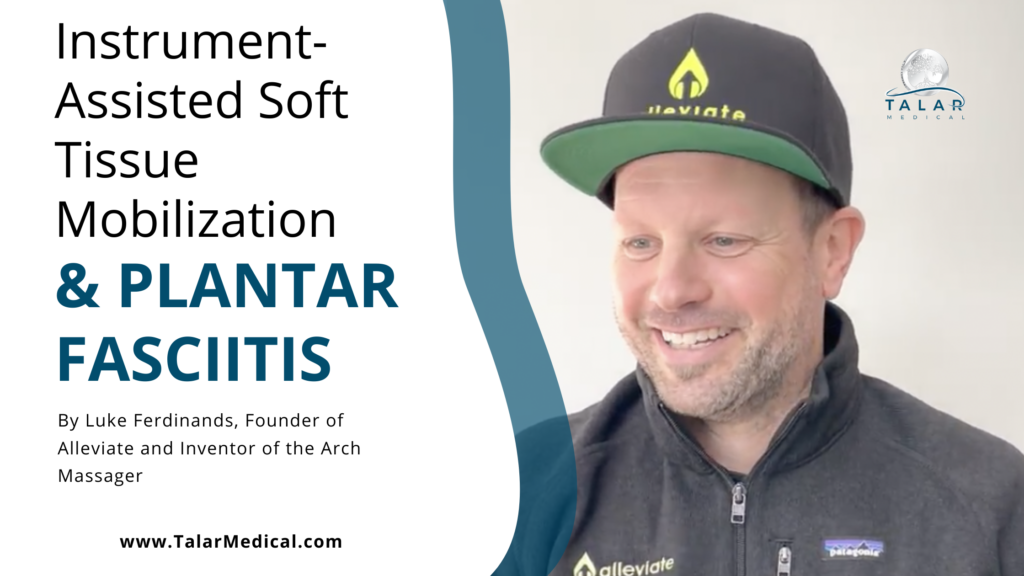
By Luke Ferdinands, Founder of Alleviate and Inventor of the Arch Massager
Instrument-Assisted Soft Tissue Mobilization (abbreviated to IASTM, commonly known as “Graston Technique” after the brand that has dominated the space) is gaining popularity in the US as a treatment modality for tendinopathies and other soft tissue ailments. In my home country of New Zealand, it’s been taught and used for decades. In fact, for most of my 18 year career I’ve used specially designed steel tools to treat both acute and chronic presentations of tissue dysfunctions – notably Plantar Fasciitis and Fasciosis.
My clinical experience tells me that it delivers patients an immediate “ah-ha” moment in the clinic and measurable pain and function improvement with continued application, even in the most stubborn recalcitrant presentations of PF. So the patient feels better right now, keeps getting better with each treatment, and it’s completely non-invasive. There is published research backing up what I see in my practice every day, which gives me the confidence to evangelize the practice.
In my humble opinion, with rare exceptions, every single person who has plantar fasciitis of any severity or longevity should get IASTM treatment to restore normal function to the tissue. In fact, nearly every single person who comes through my practice presenting with PF gets manual therapy with a steel tool on the tissues of their feet. My experience is that in almost all cases, regular application of IASTM can “bring back” even feet that are pretty far gone.
IASTM Will Catch On in Podiatric Medicine
While these techniques are still only adopted in “niches” of PT and Chiropractic in the US, I see leading indicators that this type of treatment will be widely adopted in podiatric medicine eventually. Most of the PF patients that come through my office have been recommended some form of home-based self-massage – whether that be with a tennis ball, lacrosse ball, golf ball, frozen water, or pvc pipe, or something similar. This seems to be based on a widespread, (and accurate) belief that self-massage provides symptom relief for Plantar Fasciitis.
Now – I will argue that those remedies will provide some momentary relief, but will NOT produce step-change results, nor will it create continued improvement in tissue health over time with repeated application. In other words, they provide an “ahhh” for a bit, but not an “ah-HA!” that lasts.
What differentiates IASTM from other soft-tissue treatments is in the amount of pressure being placed on the dysfunctional tissue, and the specificity of where that pressure is placed. A lacrosse ball isn’t precise enough, and the thumbs of even an expert reflexologist can’t generate enough force to break down dysfunctional tissue and allow it to heal properly. So IASTM is the best option.
The Problem with IASTM is Access
If you’re with me so far, here’s where I have to say there’s a problem – of the >3 million Americans who will get a PF diagnosis this year, the vast majority won’t have access to an expert IASTM practitioner. In all likelihood, they won’t even know to ask their doctor about it; and it’s even likely that their doctor may not think to suggest it!
To make matters worse, even if a patient knows about IASTM / Graston, can find a practitioner, can make the trip to their office, and can afford the co-pays, it’s entirely too common that they either OR they can’t see the practitioner frequently enough to complete a course of treatment all the way through. In an extreme example, I have a patient that comes to me from mid-New Hampshire to my practice in Suburban Boston – no way are they making that trip three times a week.
The Solve for the Access Problem – The Alleviate Arch Massager
This led me to think “Ok – there has to be a way to deliver an IASTM-quality treatment in a device that the patient can use themselves from home, using their own bodyweight, with easy ergonomics.” This is the basic insight that led me to start Alleviate and invent the Arch Massager, and it’s been a huge success. Basically, any patient with PF can use this tool to deliver themselves a full course of treatment in IASTM for the cost of a single copay visit to a trained practitioner.
The way I use this is in my own practice is I do one session of IASTM myself with a steel tool, then I send the patient home with an Arch Massager with the simple instructions to use it for 2-3 minutes per affected foot, every day, with an amount of pressure that “feels like it’s doing something.”
It’s been a game-changer. Even the couple members of my staff who aren’t fully trained in IASTM can show the patient the device, show them how to use it, and prescribe it to be used alongside a Home Exercise Program. We’re still collecting data, but anecdotally, patient compliance with self-IASTM is much higher than exercise, or night splints, because of the immediate feedback and noticeable day over day change. There’s also a feeling of empowerment that comes with feeling that the solution to your pain is in your hands (er…your feet….)
Here’s a video of how the product is used:
If You’d Like to Give it a Try….
Talar members have exclusive access in the podiatric medicine world to dispense the Alleviate Arch Massager in their practice, and can get it at wholesale prices we don’t offer anywhere else. We would love to help you help your patients recover from PF with a method that is highly affordable, compliance-friendly, and extremely conservative. It’s become my new first line of defense for PF, and I think it can be yours too.
Click here to get a free sample, and feel free to write me at luke@alleviatetherapy.com if you have any questions about the IASTM technique or the Alleviate Arch Massager device.

